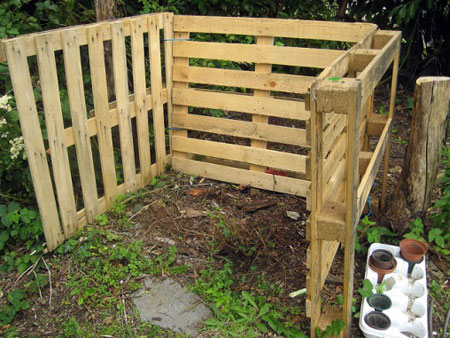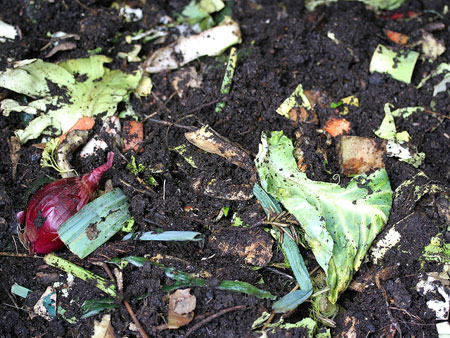Home gardeners can compost to build soil organic matter and smart soils
Make use of fallen leaves, kitchen vegetable scraps and other yard residue or waste to make stable compost for your vegetable garden.
Home gardeners can build soil organic matter and minerals through the practice of composting. A soil’s organic matter content is key to its ability to absorb and retain water. Composting methods can be either hot or cold. Maintaining a hot compost is more labor intensive, yet provides quicker compost. Vermicomposting, which involves the use of worms, is another method. Composting and vermicomposting of kitchen food scraps and yard residue on a larger scale is being researched by Michigan State University’s John Biernbaum, Department of Horticulture. Food scraps from campus are being composted with leaves from East Lansing, Michigan, and then used at the Student Organic Farm and on campus at the Bailey Greenhouse project. Produce grown from this composted organic material is supplied to campus cafeterias, thus closing the food cycle loop, which means that organic waste is being used to build soil health and grow future produce and not going to the landfill. Home gardeners can contribute to closing their own food cycle on a smaller scale using their own kitchen vegetable scraps and yard residue (waste) to create compost.
What is required for a backyard compost? Michigan State University Extension recommends an area no larger than 4 feet by 4 feet for the home gardener. Consider locating your pile near your garden for ease of transporting the compost. The pile does require mixing, so having too large a volume will make this process difficult. Construct your pile with untreated pallets, either 36 inches, 40 inches or 48 inches, wired together or with chicken wire secured to steel posts. There are also prefabricated compost bins available on the market, but many are too small for a hot pile. Enclosing your pile can help conserve moisture and heat, yet makes sure air is able to flow through. The microbes that work to breakdown the organic material in the pile require oxygen or aerobic conditions. Creating three side-by-side bins will allow a home gardener to manage compost in varying stages of decomposition. One bin will contain ready to use compost, while the middle bin will be in the stage of hot decomposition, and the first bin will be the one you use to collect new material.

Photo credit: Cianran Mooney, Flickr.com
What is the home gardener’s recipe for successful compost? What does a home gardener need to do to turn vegetable and yard residue into rich, dark organic matter? Composting requires plant or animal material applied to the pile in a ratio of approximately three brown (carbon) materials, such as decayed tree leaves or straw, to one green (nitrogen) material, such as kitchen vegetable scraps, lawn clippings or hay. Place a layer of brown material, three times that of green, and cover with a layer of green. Use some existing compost or soil between the layers; this will help in providing microorganisms to speed up the decomposition. Moisten the layers with water. Continue layering with the materials you have within the bin. This ratio can also be reduced to 2:1 or 1:1 for successful composting.
Home gardeners may find it difficult to create a hot compost if they have few sources of greens and browns. A method that they can use, and one that has been successful for students at the Bailey Greenhouse Project according to Biernbaum, is to collect the weeds, leaves and old produce that accumulate over weeks, then use that as a component for a new large pile made all at once by layering the collection pile material with purchased straw and hay as more browns and greens. A 140 degree pile will result in a few days. Home gardeners may find the added investment in hay and straw for this ‘smart’technique may be worth the quicker compost.
Make sure your pile has an adequate moisture level of 60 percent or more, as water is a key important component necessary for microbial activity that is often missing in home compost piles. A gardener can test the moisture level by squeezing a handful of material from the pile; if it oozes water, then it’s too moist. If you squeeze it and only two to three drops of water fall out, then this is at the 60 percent moisture level. If you squeeze it and the handful falls into pieces, then this is too low of moisture. Frequently monitor the moisture level of the pile and water if needed. Cover the pile if it’s raining too much, more than two inches per week, so that valuable minerals and compounds do not leach away.

Photo credit: Jadot, Flickr.com
What makes compost happen? Microbes, such as bacteria and fungi, will feed on the brown (carbon) and green (nitrogen) organic matter decomposing it into compost. Make sure your pile reaches an internal temperature of 130-140 degrees if you want to kill weed seeds. You can purchase a soil thermometer to measure the internal temperature of your pile or if you reach your hand into the pile’s center, and can’t hold onto the material, it is likely above the 130 degree range. This temperature promotes microorganisms that will speed the decomposition. It also helps to kill any weed seeds including those from vegetable scraps such as tomato or melon seeds.
How long will it take? You can get your pile to decompose and be ready to use as soil ammendment in one garden season, or six months time. If you’d like to speed up the process with more time and energy spent, you can get a pile to decompose in four to six weeks by using hot composting with more frequent turning. Try this sustainable practice and be amazed by the results! If you want to use your compost to germinate seeds, that often requires eight to 12 months for the compost to fully mature.
For more information on a wide variety of Smart Gardening topics, visit the Gardening in Michigan website at www.migarden.msu.edu or contact MSU’s toll-free garden hotline at 1-888-678-3464.



 Print
Print Email
Email



